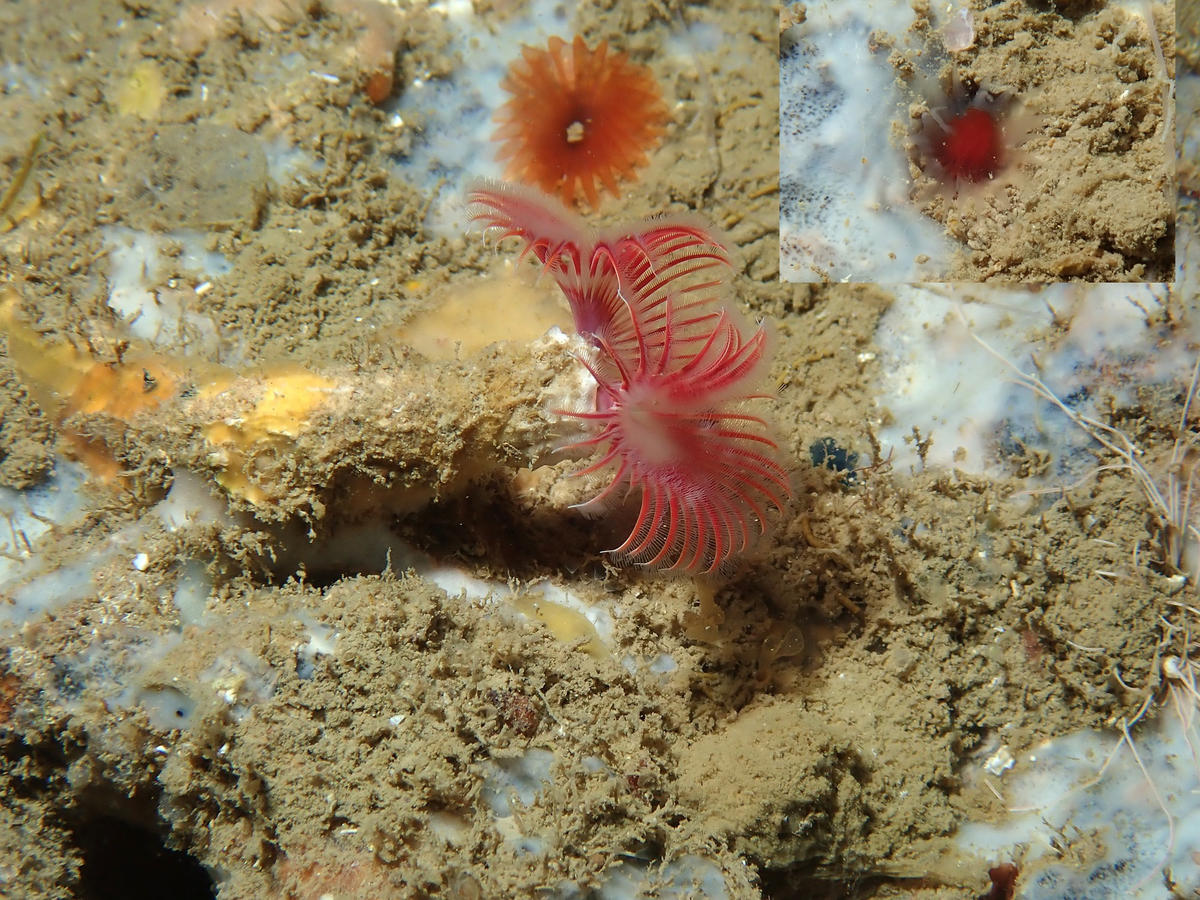
François ROCHE le 20/05/19
Bonjour,
Connaissez-vous ce petit vers rouge-orange rencontré à l'entrée de l'un des tunnels des iles Médès (Catalogne) ?
Merci,
François
Leslie Harris le 22/05/19
Thank you, François, Vincent & Frédéric for the additional information & suggestion. The radioles of Chone, Dialychone, Paradialychone, and Euchone are usually fused by a palmate membrane only at the base or for a short distance along the radioles. In the redescription of Dialychone acustica by Tover-Hernandez (2007, as Chone acustica), she states that the palmate membrane may be very low or up to one half of the branchial crown length. She also says that the lateral flanges along the radioles are narrow, which means that figure 3A is not accurate. In the orange sabellid the palmate membrane is unusual in its length and the extremely broad lateral flanges.
Geoff Read thinks it might be a Myxicola due to the degree of fusion of the palmate membrane. He may be right. As I mentioned before, while this worm is unusual for Geoff and me it may be very familiar to local specialists like Adriana Giangrande or Margaret Licciano.
(Edit Fred A.: merci beaucoup Leslie pour ton aide. Pour ceux qui ne lisent pas bien l'anglais, voici la traduction de ton texte :
"Merci, François, Vincent & Frédéric pour les informations et suggestions supplémentaires. Les radioles de Chone, Dialychone, Paradialychone, et Euchone sont habituellement fusionnées par une membrane palmée seulement à la base ou sur une courte distance le long des radioles. Dans la nouvelle description de Dialychone acustica par Tover-Hernandez (2007, comme Chone acustica), elle déclare que la membrane palmée peut être très basse ou atteindre la moitié de la longueur de la couronne branchiale. Elle dit aussi que les rebords latéraux le long des radioles sont étroits, ce qui signifie que la figure 3A n'est pas exacte. Chez le sabellaire orange, la membrane palmée est inhabituelle par sa longueur et ses ailes latérales extrêmement larges.
Geoff Read pense qu'il pourrait s'agir d'un Myxicola en raison du degré de fusion de la membrane palmée. Il a peut-être raison. Comme je l'ai déjà mentionné, bien que ce ver soit inhabituel pour Geoff et moi, il peut être très familier à des spécialistes locaux comme Adriana Giangrande ou Margaret Licciano.
Traduit avec www.DeepL.com/Translator )
Frédéric ANDRÉ le 22/05/19
Une simple hypothèse/proposition : Dialychone acustica ?
Frédéric ANDRÉ le 22/05/19
Juste pour compléter nos observations, on compte le plus souvent 24 tentacules, si cela peut aider à sa determination.
Vincent MARAN le 21/05/19
Bonsoir
C'est une espèce que l'on trouve également sur notre littoral. La petite taille des individus et le prolongement translucide des appendices sont assez caractéristiques. Il est assez farouche et souvent dans des petites anfractuosités rocheuses.
François ROCHE le 21/05/19
Merci Leslie pour ces avis très intéressants.
Pour ma part, la collecte de spécimens sur les Iles Médès ne sera pas possible, car tous les sites de plongée sont situés dans une réserve intégrale. Mais peut-être que d'autres plongeurs en rencontreront prochainement et pourront en collecter.
Et n'hésitez pas à repasser sur DORIS... ;-)
François
Leslie Harris le 21/05/19
Geoff Read, another polychaete specialist, and I have been discussing François Roche's image on iNaturalist. We are both very intrigued by this animal. He is willing to call it a Myxicola; I am not. Would anyone be willing to collect a few and photograph them out of their tubes? The appearance of the anterior body should be enough to confirm the genus if it is Myxicola.
Of course, this could be a very common and well-known species for your area. Our geographic expertise is for New Zealand (Geoff) and the north Pacific (me). Adriana Giangrande should be able to recognize it if it is described.
Leslie Harris le 21/05/19
This is embarrassing! I should have looked at this post by Frédéric ANDRÉ http://doris.ffessm.fr/Forum/ver-tubicole5/(rOffse... first, as it links to several other photos of the orange beast. Wow!! this is amazing. I must change my opinion since there are clearly pinnules. After enlarging the image of polychaete 17 it's clear that the radioles are fused. Only the lower portion of the radioles are fused in Chone & Euchone so it's unlikely to be either one of those genera. I need to go through my literature to see if there's a name for this.
Leslie Harris le 21/05/19
(Apologies for the English) To my knowledge these animals do not resemble any sabellid or serpulid. Both families have delicate pinnules along the individual radioles of the crown, which also has a distinct central opening leading to the mouth. These do not seem to have the pinnules or the opening. The flat central area is suggestive of an anemone. The extended clear, flat (?) tentacles combined with the orange color seem very distinctive. Is there a cnidarian expert you can ask about this?
François ROCHE le 20/05/19
Effectivement, il revient régulièrement sur le forum. Merci Frédéric.
P.S. : j'avais tapé "vers orange" dans le moteur de recherche du forum, et ça n'avais pas donné grand'chose... -;)
François
Frédéric ANDRÉ le 20/05/19
Bonjour François,
Je pense à un petit vers sédentaire (tube fixé) à panache du genre Euchone ou Chone. (tape "chone" dans le moteur du forum pour voir d'autres photos).
François ROCHE le 20/05/19
Sur cette 2ème photo, il est flou en arrière plan, mais déployé. Quand je me suis approché, il s'est rétracté en un éclair. La partie orange est concentrée au centre, alors qu'une partie transparente semble rester déployée (encadré en haut à droite).
Toujours en milieu sombre.

Les textes et images sont sous licence et ne sont pas libres de droit.
Pour les ayants-droits, connectez-vous.
Pour toute demande d'utilisation (exemple d'un formateur Bio de la FFESSM...) contactez nous ici.